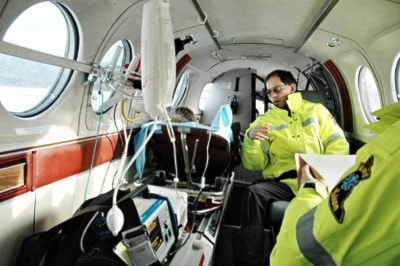The call came in around 10:30 a.m.
The mission: to transport a sick and bleeding patient from the Mayo health centre to Whitehorse General Hospital for further care.
Just before 11:30 a.m., medevac flight nurse Dave Hersey and paramedic Eric Stang boarded a King Air 200 air ambulance at the Whitehorse International Airport.
“We try to time it so that it is an hour from the time we get the call to the time we are in the air,” said Hersey.
They load a collapsible stretcher into the aircraft and then secure bags of medical equipment inside the plane.
There are three seats on the plane. Hersey and Stang occupied two of them, sitting across from a stretcher, bags of intravenous fluid, oxygen masks and machines that measure blood-oxygen levels, blood pressure and a patient’s heartbeat.
They also brought along a well-stocked bag of medication and a first-aid kit containing bandages, splints and other emergency equipment.
The flight to Mayo took 40 minutes.
Stang and Hersey were calm and relaxed.
It’s clear this is routine.
Hersey has been a flight nurse for about 18 months. He makes six to eight emergency flights a month.
“In a year, my comfort level has really gone up,” said Hersey who has delivered two babies since he began this career.
To become a flight nurse, Hersey had to graduate as a registered nurse, which requires four years of schooling.
He then gained significant training and experience in intensive and emergency care at the University of Alberta hospital in Edmonton.
After that, he continued to take courses in advanced life support before he was ready to take flight.
“What I like about this job and why it requires so much training is because you’re the one that gets to make the decisions up here,” said Hersey.
“There are protocols, but if something happens you have to treat the patient how you see fit in order to give them the best care.”
Patients are ranked according to the severity of their illness or injury.
Critically ill patients are dubbed level one. Transporting them requires two flight nurses, or possibly a flight doctor and a nurse. A level-five patient requires only a nurse and a medic.
The Mayo patient is considered level three; she is bleeding and her ability to carry oxygen in her blood is impaired.
After the plane touched down in Mayo, Hersey and Stang gently guided the patient from a ground ambulance into the plane.
Once aboard, she was placed on a stretcher and wrapped in blankets to protect her from the cold.
It was minus 40 Celsius that morning.
She was attached to portable monitors and Stang kept an eye on her blood pressure and pulse and administered oxygen just after take-off.
The plane was in Mayo for only about five minutes before leaving for Whitehorse.
The flight to Whitehorse was routine.
The medical staff kept an eye on the patient and filled out the forms that will tell her doctors in Whitehorse about her ailment.
In a small, tightly wrapped box lay vials of the patient’s blood taken in Mayo.
There is only so much the health centres in communities like Mayo can do, so patients often travel with their own blood samples, which will be tested further in Whitehorse, or their final destination.
Not all flights end in Whitehorse.
Critically ill patients who need procedures that cannot be performed at the Whitehorse hospital are flown to larger centres, like Vancouver, Edmonton or Calgary.
Fifty per cent of the Yukon medevac flights remain within the territory; the others go to southern provinces.
“There’s really not a lot of jobs like this,” said Hersey on the way back to Whitehorse.
“The Yukon is pretty unique, with its communities spread out all over the place. Most provinces rely on ground ambulance services much more.
“Most flight nurses only ever get to go to one city, but I get to go all over the place.
I’ve been to Vancouver, Calgary and Edmonton, for example.
“It’s a pretty cool job.”
At the Whitehorse airport, the patient is taken off the plane in a stretcher, feet first, loaded onto a gurney and then into the back of an ambulance.
En route to the hospital, the ambulance is silent. Because the patient is stable and alert, there’s no need for sirens.
At Whitehorse General Hospital, the patient does get the same care she received in Mayo — she’s wheeled gently into the hospital, guided by both Stang and Hersey.
Mission accomplished.
